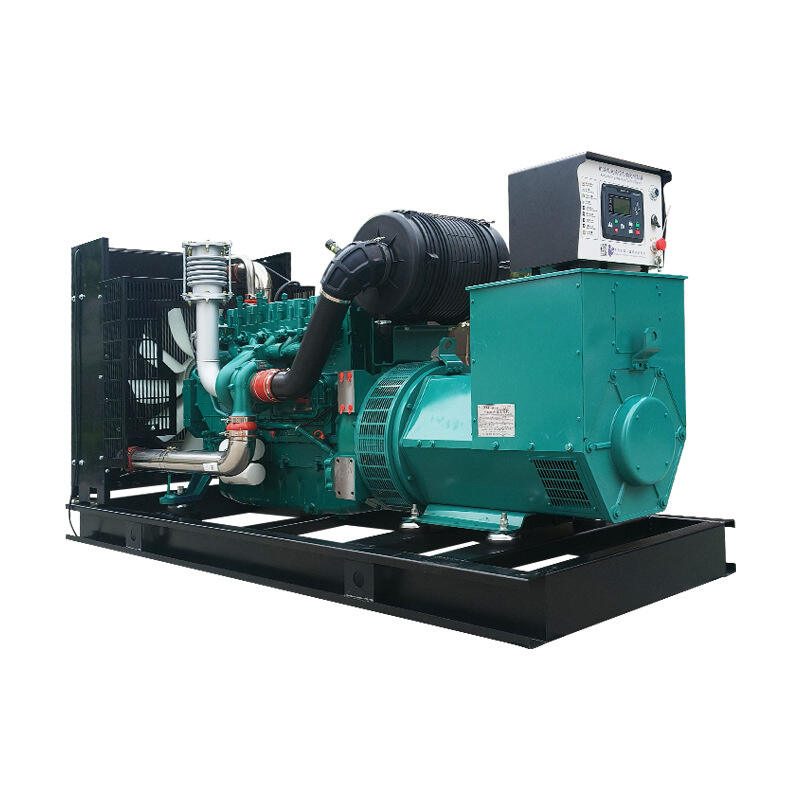Maksimer din generators levetid gjennom strategisk vedlikehold
Å oppnå 10 000 driftstimer med ditt Cummins generator sett representerer et betydelig milepæl innen pålitelighet i kraftproduksjon. Denne omfattende guiden utforsker essensielle vedlikeholdsprosedyrer som bidrar til å forlenge din generators levetid samtidig som optimal ytelse opprettholdes. Uansett om du administrerer et kritisk reservestrømsystem eller er avhengig av kontinuerlig kraftforsyning, vil disse ekspertinnspillene hjelpe deg med å maksimere din investering og sikre jevn drift.
Viktige komponenter og regelmessige inspeksjoner
Motoroljebehandling og analyse
Hjertet i enhver Cummins generatorsett vedlikeholdsprogram starter med riktig oljehåndtering. Regelmessig oljeanalyse gir viktige innsikter i din generators indre tilstand. Fagteknikere anbefaler å sjekke oljenivået daglig og gjennomføre fullstendig oljeskifte hvert 250–500 driftstimer, avhengig av bruksmønster og miljøforhold. Laboratorieanalyse av brukt olje kan avsløre tidlige tegn på slitasje, forurensning eller potensielle mekaniske problemer før de blir alvorlige.
Å implementere et systematisk oljeprøvetakingsprogram hjelper til med å spore slitasjemønstre i motoren over tid. Denne proaktive tilnærmingen gjør at vedlikeholdslag kan oppdage potensielle problemer på et tidlig tidspunkt, noe som reduserer risikoen for uventet nedetid og forlenger komponentenes levetid. Husk alltid å bruke oljekvaliteter anbefalt av produsenten, og hold nøye oversikt over intervaller for oljeskift og resultater fra analyse.
Vedlikehald av kjølesystem
Kjølesystemet har en viktig rolle når det gjelder å opprettholde optimale driftstemperaturer for din Cummins generatorsett. Regelmessig inspeksjon og vedlikehold av nivået på kjølevæske, rens av radiator og remmestramming er avgjørende. Kjølevæsken bør testes hvert 1 000 driftstime for å sjekke konsentrasjon og kjemisk balanse, slik at korrosjon unngås og varmeoverføring sikres.
Rengjøring av radiatorfinner og sikring av ordentlig luftstrøm rundt enheten forhindrer overoppheting. Vær spesielt oppmerksom på kjølemiddelslanger, og sjekk etter tegn på slitasje, svelling eller revner. Erstatt umiddelbart alle skadde deler for å forhindre lekkasje av kjølemiddel som kan føre til motorstørrelse.
Drivstoffsystemoptimalisering
Drivstoffkvalitetsstyring
Opprettholdelse av drivstoffkvalitet er avgjørende for levetiden på din Cummins generatorsett. Gjennomfør et jevnt program for drivstofftesting og polering for å fjerne vann, sedimenter og mikrobiell vekst. Installer og vedlikehold høykvalitets drivstoffilter, og erstatt dem i henhold til produsentens spesifikasjoner eller når differensielt trykk indikerer begrensning.
Vurder å installere et drivstoffpoleringsystem for generatorer som drives sjelden eller lagrer store mengder drivstoff. Dette hjelper til med å forhindre nedbrytning av drivstoff og sikrer at rent drivstoff alltid er tilgjengelig når det trengs. Regelmessig inspeksjon av drivstoffsystemet bør inkludere sjekk for lekkasjer, riktig drivstofftrykk og tegn på forurensning.
Praksis for lagring av drivstoff
Riktig lagring av drivstoff påvirker kraftig generatorens ytelse og pålitelighet. Hold drivstofftankene på anbefalte nivåer for å minimere kondensdannelse samtidig som det sikres tilstrekkelig forsyning. Tøm vannavskillerne regelmessig og test drivstoffkvaliteten, spesielt i fuktige omgivelser eller når drivstoff er lagret over lengre tid.
Vurder å behandle lagret drivstoff med passende stabilisatorer og biocider for å hindre nedbrytning og mikrobiell vekst. Implementer en rotasjonsplan for lagret drivstoff for å opprettholde friskhet og unngå opphopning av gammelt drivstoff som kan påvirke ytelsen.
Luftsystem og filtrering i høy kvalitet
Vedlikehold av luftfilter
Ren luft er avgjørende for optimal forbrenning og motorlevetid. Regelmessig inspeksjon og utskifting av luftfilter forhindrer abrasive partikler i å komme inn i motoren. Overvåk indikatorer for luftfiltertilstopping og rens eller skift filter ved behov, i stedet for å kun stole på fastsatte intervaller.
Sørg for at luftinntakssystemet er korrekt tetting og uten lekkasjer som kan tillate ufiltrert luft inn i motoren. Regelmessig inspeksjon av luftinntaksdeler, inkludert rør, klemmer og tetninger, bidrar til å opprettholde systemintegritet og forhindre tidlig motor slitasje.
Miljøhensyn
Driftsmiljøet påvirker betydelig vedlikeholdsbehovet for luftsystemet. I støvete eller skitne forhold bør inspeksjonsfrekvensen økes, og man bør vurdere ekstra filtreringsløsninger. Oppretthold rene forhold rundt aggregatsettet og sørg for god ventilasjon for å redusere belastningen på luftfiltreringssystemene.
Installasjon av ekstra pre-renseanordninger eller to-trinns filtreringssystemer kan være nyttig i krevende miljøer. Regelmessig rengjøring av generatorhuset og omkringliggende område hjelper til med å redusere mengden søppel som kommer inn i luftsystemet.

Pålitelighet i elektrisk system
Vedlikehald av batteri
Et godt vedlikeholdt batterisystem er avgjørende for pålitelig start av generatorer. Regelmessig testing av batteritilstanden, inkludert spenningssjekk og belastningstesting, bidrar til å forhindre startfeil. Rengjør batteriterminaler og tilkoblinger månedlig, og sjekk etter tegn på korrosjon eller skader.
Overvåk batteriladesystemer for å sikre riktig funksjon, og hold nivået på batterivæsken i ikke-vedlikeholdsfriske batterier. Vurder å innføre et batteriutskiftingsprogram basert på alder og tilstand, i stedet for å vente med utskifting til det har oppstått feil.
Vedlikehold av generatorende
Regelmessig inspeksjon og testing av generatorenden sikrer pålitelig strømytelse. Sjekk isolasjonsmotstand i viklinger årlig eller etter lengre perioder med inaktivitet. Hold generatorenden ren og tørr, og overvåk den for tegn på fuktighet eller forurensning som kan påvirke den elektriske ytelsen.
Inspekter alle elektriske tilkoblinger regelmessig, og sørg for riktig moment på klemtilkoblinger samt sjekk etter tegn på overoppheting eller skader. Regelmessig termografisk scanning kan hjelpe med å identifisere potensielle problemer før de fører til feil.
Ofte stilte spørsmål
Hvor ofte bør jeg utføre lastbanktesting på min Cummins generatorsett?
Lastbanktesting bør utføres årlig eller etter enhver større vedlikeholdsarbeid. Denne testen sikrer at generatoren kan yte i full kapasitet og bidrar til å forhindre våtstabling i dieselmotorer som regelmessig kjører under lette belastninger.
Hva er tegnene som indikerer at min generator trenger umiddelbar vedlikehold?
Viktige advarselstegn inkluderer uvanlige lyder, overdreven vibrasjon, røyk fra eksosen, redusert ytelse, økt drivstofforbruk eller advarslamper på kontrollpanelet. Eventuelle av disse symptomene krever umiddelbar inspeksjon av kvalifiserte teknikere.
Hvordan kan jeg forlenge levetiden til min generator utover 10 000 timer?
Å forlenge levetiden til en generator utover 10 000 timer krever streng overholdelse av vedlikeholdsplaner, bruk av kvalitetsdeler og væsker, grundige vedlikeholdsdokumentasjoner og rask håndtering av eventuelle problemer. Regelmessige profesjonelle inspeksjoner og kontinuerlig overvåking av driftsparametere har også avgjørende betydning for levetid.
Hva er betydningen av korrekt dokumentasjon i vedlikehold av generatorer?
Korrekt dokumentasjon hjelper til med å følge opp vedlikeholdshistorikk, identifisere mønstre i ytelse eller problemer, sikre etterlevelse av garantiavtaler og effektiv planlegging av forebyggende vedlikehold. Oppretthold detaljerte logger over alle tjenester, reparasjoner og driftsparametere for optimal langtidsstyring.

